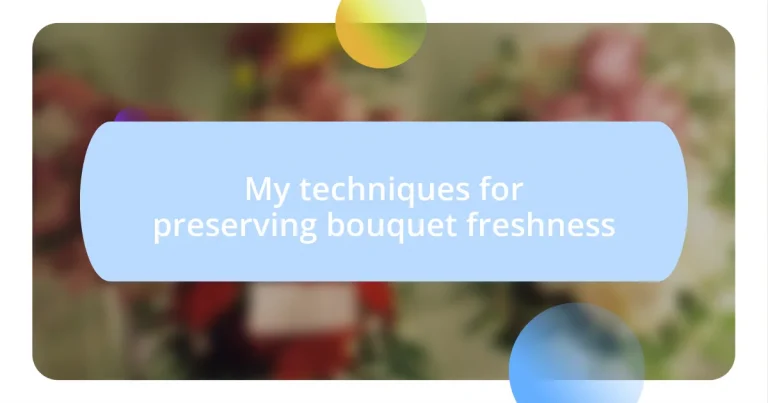Key takeaways:
- Choose compatible flowers based on their water needs and sturdiness to enhance bouquet longevity.
- Properly prepare flowers by trimming stems, removing excess foliage, hydrating them, and using flower food.
- Address common issues like wilting and odors by using warm water, separating ethylene-producing flowers, and maintaining clean vases.

Choosing the right flowers
Choosing the right flowers really sets the stage for how long your bouquet will last. When I first started arranging flowers, I learned the hard way that not all blooms are created equal. For instance, I once paired delicate peonies with robust sunflowers, and while they looked stunning together, the peonies wilted far too quickly, leaving the display uneven and sad.
I often find myself gravitating towards hardy flowers, especially if I want my arrangements to thrive for an extended period. For example, I love including chrysanthemums or alstroemerias; they not only offer beautiful colors but also tend to hold up well over time. It’s fascinating to think about how certain flowers can really embody the message or feeling you’re trying to convey—don’t you want those feelings preserved as long as possible?
As I explore different flower combinations, I pay attention to their compatibility. Combining flowers with similar water needs can make a big difference in longevity. Have you ever mixed flowers only to watch one type droop while others thrive? I remember the disappointment of saw my sweet lilies struggling next to thirsty roses. Learning to choose flowers that complement each other has transformed my arrangements from simply beautiful to lasting works of art.

Preparing your bouquet
When it comes to preparing your bouquet, the process is just as crucial as choosing the right flowers. I remember the excitement of picking fresh blooms from my garden, only to realize later that I hadn’t properly conditioned them. Conditioning is essentially giving your flowers a little TLC before they head into the vase. It makes all the difference!
Here’s how I like to prepare my blooms:
- Trim the stems: Cut them at an angle, about an inch from the bottom. This increases the surface area for water absorption.
- Remove excess foliage: Pluck off any leaves that will sit below the waterline; it simply helps reduce bacteria growth.
- Hydrate the flowers: Let them drink up in fresh, clean water for a few hours before arranging. I find this revitalizes their vibrancy immensely.
- Use flower food: If you have it on hand, adding a packet of flower food not only nourishes the blooms but also extends their life.
I can recall a time when I skipped this prep stage, thinking, “They’ll be fine!” Oh, how wrong I was! The flowers drooped within a day. Now, I carry out these steps religiously, and my bouquets are always radiant and long-lasting. Embracing this routine has transformed my arrangement game, turning what could be a fleeting display into an enduring piece of nature.

Hydration techniques for freshness
When it comes to hydration techniques for freshness, understanding how much water your bouquet needs is essential. I’ve often heard the saying, “A thirsty flower is a sad flower,” and that rings incredibly true in my experience. For instance, during one particularly hot summer, I saw flowers wilt within hours because I didn’t check the water level regularly. Now, I make it a point to keep the vase filled, as flowers tend to drink a lot of water, especially on warm days.
One of my favorite methods involves using a flower preservative. I remember the first time I tried a homemade solution made from sugar and vinegar—what a revelation! The sugar provides energy while the vinegar acts as an antibacterial agent. It’s like giving my flowers a nourishing energy drink. I noticed my blooms remained vibrant longer, making every bouquet a little masterpiece. Have you ever experimented with your own preservative? If you haven’t, I guarantee it’s worth a try.
Another technique I’ve found effective is changing the water every couple of days. Early in my flower arranging journey, I often neglected this step, thinking they were fine. But letting stagnant water sit—typically filled with bacteria—was a disservice to my flowers. After committing to this routine, I’ve seen remarkable changes in their lifespan and overall health. It’s incredible how such a simple action can drastically extend the beauty of a bouquet.
| Technique | Description |
|---|---|
| Maintain Water Level | Keep the vase filled with fresh water. |
| Use Flower Preservative | A mix of sugar and vinegar can help nourish blooms. |
| Change Water Regularly | Replace stagnant water every couple of days to prevent bacteria. |

Maintaining optimal temperature
Maintaining the right temperature for your bouquet can be a game changer. I vividly remember a wedding I attended in the summer, where the temperature soared, and the beautiful centerpieces suffered. They were wilting before the reception even began! Since then, I’ve understood just how much temperature influences flower longevity.
When I bring home fresh blooms, I try my best to keep them in a cool spot—away from direct sunlight and heat sources. I find that even placing them in a cooler room for a few hours can enhance their freshness. A little adjustment like this can make your arrangements last days longer. Have you noticed how flowers thrive in a cooler environment?
Conversely, if the air is chilly, I always take care not to let them freeze. I once made the mistake of keeping my tulips outside during a mild frost, only to witness them droop the next day. It was heartbreaking! Now, I’ve learned that keeping flowers at a balanced temperature is crucial to maintaining their beauty. So, whether it’s summer heat or winter chill, I’m always mindful of the atmospheric conditions surrounding my bouquets.

Best preservation solutions
When it comes to the best preservation solutions, I’ve discovered that adding a splash of lemon-lime soda to the water can do wonders. I remember a particularly vibrant arrangement of mixed flowers; when I decided to experiment with this method, those blooms seemed to perk up almost instantly. The sugars in the soda provide that much-needed energy, while the acidity helps keep bacteria at bay. Isn’t it fascinating how a simple ingredient can breathe new life into a bouquet?
Another standout solution I’ve come across is the use of floral foam. Initially, I was skeptical about using it, thinking it was just for professional florists. However, I tried it out for a family gathering, and the results were astounding! The foam holds onto moisture while allowing for excellent water distribution, keeping each stem hydrated evenly. It felt like giving my flowers a spa day, and the guests were consistently impressed with the freshness of my arrangements.
Lastly, I’ve had great success with placing a few aspirin tablets into the water. I stumbled upon this tip during a late-night internet search, and it piqued my curiosity. After trying it with a particularly stubborn bouquet that always seemed to droop quickly, I was pleasantly surprised to see them stand tall for almost an entire week afterward. Have you ever thought about how common household items can transform something as delicate as flowers? It’s a reminder to look for innovative, everyday solutions for those unexpected freshness challenges.

Techniques for prolonging longevity
When it comes to techniques for prolonging the longevity of my bouquets, I can’t stress enough the importance of trimming the stems. I remember once receiving a stunning bouquet, but after a few days, the vibrancy faded. It turned out I hadn’t cut the stems when I first placed them in water. I learned that a fresh cut—not too long, just enough to remove any dry or damaged parts—allows the flowers to absorb water more effectively. Have you ever tried cutting stems at an angle? This small adjustment can significantly enhance hydration.
Incorporating flower food into the water is another technique that I swear by. I used to overlook those little packets that come with store-bought arrangements, but now I treat them like gold. The last time I followed this routine, my flowers lasted nearly two weeks! Imagine the delight of walking into a room and being greeted by the same gorgeous blooms that once brightened my day. And here’s a fun thought: have you noticed how much care goes into feeding ourselves? Flowers deserve just as much attention and nourishment!
Lastly, I’ve discovered the magic of rehydration. There was a time when I thought half a day out of water was no big deal. But one day, after a weekend trip, I found my centerpiece drooping sadly on the table. After a gentle soak in water, I watched them perk up like they’d had a refreshing drink. I often ask myself, how important is it to stay hydrated, even for flowers? It’s a lesson that resonates for both nature and us. So, I make it a point to check water levels regularly and give my bouquets a little love whenever needed.

Troubleshooting common freshness issues
Sometimes, despite our best efforts, bouquets can still show signs of wilting or drooping. I had this frustrating experience with a beautiful tulip arrangement I received for my birthday. Just two days in, they were sagging, and it broke my heart. What I learned is that warm water can actually revive those sad blooms. By replacing the water with warm temperatures, I found the tulips absorbed much faster, and it felt like I had reignited their energy!
Another issue I’ve faced is discoloration of the petals, which can really diminish a bouquet’s overall appeal. I remember a vibrant arrangement turning a bit brown at the edges because I had mixed certain flowers together. Did you know that some flowers naturally emit ethylene gas, which can age nearby blooms prematurely? I’ve since made it a point to separate ethylene-producing flowers (like lilies) from those sensitive to it. It’s amazing how paying attention to flower compatibility can extend the life of your arrangements.
Lastly, I’ve encountered mysterious foul odors from my vases, and I quickly learned it was due to bacteria buildup. After a couple of days with what used to be my lovely centerpiece, I was left with an unpleasant surprise. I started cutting the stems more often and cleaning the vases with a mixture of water and vinegar to not just eliminate the smell, but to keep everything fresh. Have you ever had that ‘aha’ moment when a little cleaning goes a long way? It’s a simple solution that has made a world of difference in how I maintain my bouquets.














